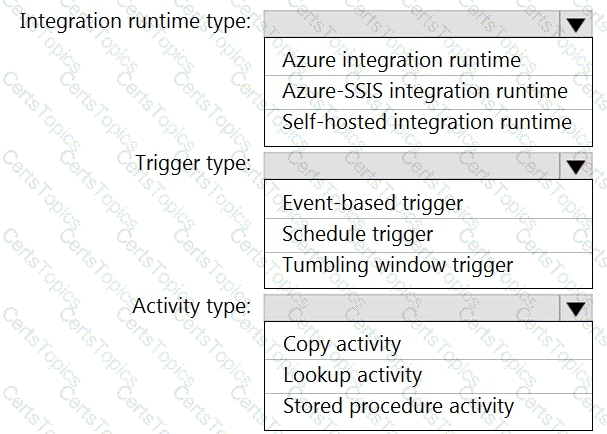You have an Azure Storage account that generates 200,000 new files daily. The file names have a format of {YYYY}/{MM}/{DD}/{HH}/{CustomerID}.csv.
You need to design an Azure Data Factory solution that will load new data from the storage account to an Azure Data Lake once hourly. The solution must minimize load times and costs.
How should you configure the solution? To answer, select the appropriate options in the answer area.
NOTE: Each correct selection is worth one point.
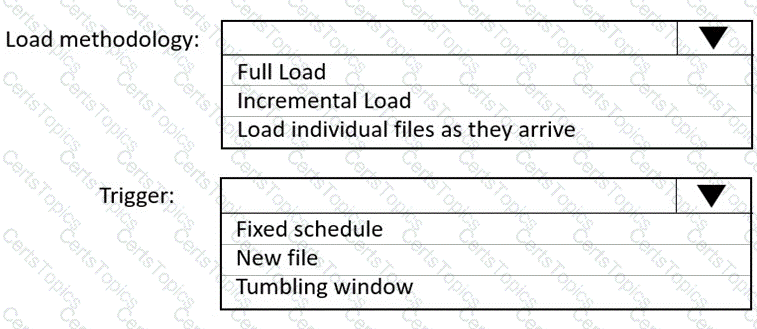
You have an Azure Synapse Analytics serverless SQL pool, an Azure Synapse Analytics dedicated SQL pool, an Apache Spark pool, and an Azure Data Lake Storage Gen2 account.
You need to create a table in a lake database. The table must be available to both the serverless SQL pool and the Spark pool.
Where should you create the table, and Which file format should you use for data in the table? TO answer, select the appropriate options in the answer area.
NOTE: Each correct selection is worth one point.
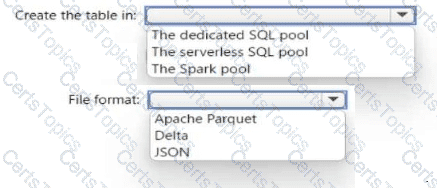
You have an Azure subscription that contains an Azure Synapse Analytics account and a Microsoft Purview account.
You create a pipeline named Pipeline1 for data ingestion to a dedicated SQL pool.
You need to generate data lineage from Pipeline1 to Microsoft Purview.
Which two activities generate data lineage? Each correct answer presents a complete solution.
NOTE: Each correct selection is worth one point.
Note: This question is part of a series of questions that present the same scenario. Each question in the series contains a unique solution that might meet the stated goals. Some question sets might have more than one correct solution, while others might not have a correct solution.
After you answer a question in this section, you will NOT be able to return to it. As a result, these questions will not appear in the review screen.
You plan to create an Azure Databricks workspace that has a tiered structure. The workspace will contain the following three workloads:
A workload for data engineers who will use Python and SQL.
A workload for jobs that will run notebooks that use Python, Scala, and SOL.
A workload that data scientists will use to perform ad hoc analysis in Scala and R.
The enterprise architecture team at your company identifies the following standards for Databricks environments:
The data engineers must share a cluster.
The job cluster will be managed by using a request process whereby data scientists and data engineers provide packaged notebooks for deployment to the cluster.
All the data scientists must be assigned their own cluster that terminates automatically after 120 minutes of inactivity. Currently, there are three data scientists.
You need to create the Databricks clusters for the workloads.
Solution: You create a Standard cluster for each data scientist, a High Concurrency cluster for the data engineers, and a Standard cluster for the jobs.
Does this meet the goal?
You plan to develop a dataset named Purchases by using Azure databricks Purchases will contain the following columns:
• ProductID
• ItemPrice
• lineTotal
• Quantity
• StorelD
• Minute
• Month
• Hour
• Year
• Day
You need to store the data to support hourly incremental load pipelines that will vary for each StoreID. the solution must minimize storage costs. How should you complete the rode? To answer, select the appropriate options In the answer area.
NOTE: Each correct selection is worth one point.
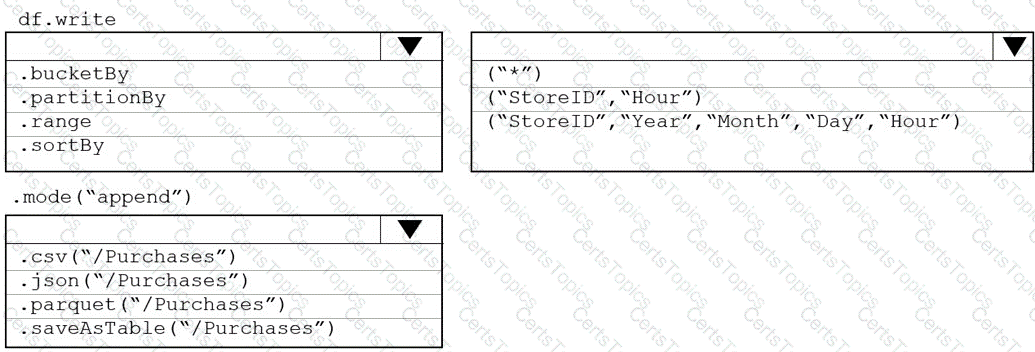
You are designing an Azure Databricks table. The table will ingest an average of 20 million streaming events per day.
You need to persist the events in the table for use in incremental load pipeline jobs in Azure Databricks. The solution must minimize storage costs and incremental load times.
What should you include in the solution?
You have an Azure Synapse Analytics pipeline named Pipeline1 that contains a data flow activity named Dataflow1.
Pipeline1 retrieves files from an Azure Data Lake Storage Gen 2 account named storage1.
Dataflow1 uses the AutoResolveIntegrationRuntime integration runtime configured with a core count of 128.
You need to optimize the number of cores used by Dataflow1 to accommodate the size of the files in storage1.
What should you configure? To answer, select the appropriate options in the answer area.
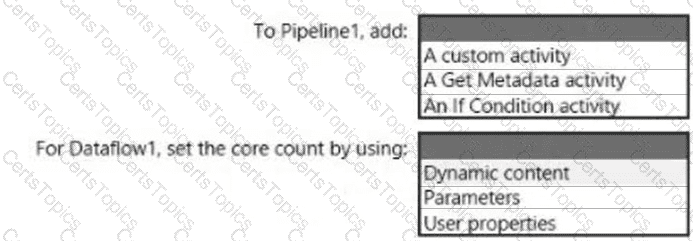
You have an Azure data factory.
You need to ensure that pipeline-run data is retained for 120 days. The solution must ensure that you can query the data by using the Kusto query language.
Which four actions should you perform in sequence? To answer, move the appropriate actions from the list of actions to the answer area and arrange them in the correct order.
NOTE: More than one order of answer choices is correct. You will receive credit for any of the correct orders you select.
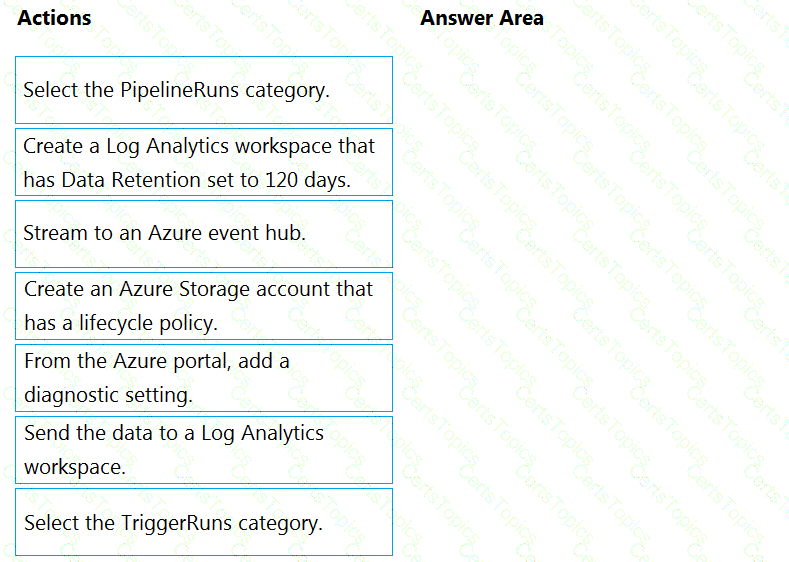
Note: This question is part of a series of questions that present the same scenario. Each question in the series contains a unique solution that might meet the stated goals. Some question sets might have more than one correct solution, while others might not have a correct solution.
After you answer a question in this section, you will NOT be able to return to it. As a result, these questions will not appear in the review screen.
You have an Azure Synapse Analytics dedicated SQL pool that contains a table named Table1.
You have files that are ingested and loaded into an Azure Data Lake Storage Gen2 container named container1.
You plan to insert data from the files in container1 into Table1 and transform the data. Each row of data in the files will produce one row in the serving layer of Table1.
You need to ensure that when the source data files are loaded to container1, the DateTime is stored as an additional column in Table1.
Solution: You use an Azure Synapse Analytics serverless SQL pool to create an external table that has an additional DateTime column.
Does this meet the goal?
You are designing a sales transactions table in an Azure Synapse Analytics dedicated SQL pool. The table will contains approximately 60 million rows per month and will be partitioned by month. The table will use a clustered column store index and round-robin distribution.
Approximately how many rows will there be for each combination of distribution and partition?
You need to create an Azure Data Factory pipeline to process data for the following three departments at your company: Ecommerce, retail, and wholesale. The solution must ensure that data can also be processed for the entire company.
How should you complete the Data Factory data flow script? To answer, drag the appropriate values to the correct targets. Each value may be used once, more than once, or not at all. You may need to drag the split bar between panes or scroll to view content.
NOTE: Each correct selection is worth one point.

You have an Azure Synapse Analytics dedicated SQL pool that hosts a database named DB1 You need to ensure that D81 meets the following security requirements:
• When credit card numbers show in applications, only the last four digits must be visible.
• Tax numbers must be visible only to specific users.
What should you use for each requirement? To answer, select the appropriate options in the answer area
NOTE: Each correct selection is worth one point.

You have an Azure Synapse Analytics pipeline named pipeline1 that has concurrency set to 1.
To run pipeline 1, you create a new trigger as shown in the following exhibit.
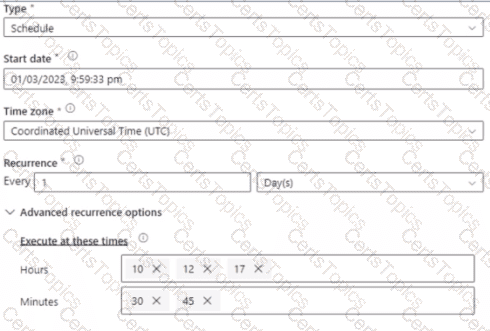
Use the drop-down menus to select the answer choice that completes each statement based on the information presented in the [graphic.
NOTE: Each correct selection is worth one point.

You are designing an Azure Data Lake Storage Gen2 structure for telemetry data from 25 million devices distributed across seven key geographical regions. Each minute, the devices will send a JSON payload of metrics to Azure Event Hubs.
You need to recommend a folder structure for the data. The solution must meet the following requirements:
Data engineers from each region must be able to build their own pipelines for the data of their respective region only.
The data must be processed at least once every 15 minutes for inclusion in Azure Synapse Analytics serverless SQL pools.
How should you recommend completing the structure? To answer, drag the appropriate values to the correct targets. Each value may be used once, more than once, or not at all. You may need to drag the split bar between panes or scroll to view content.
NOTE: Each correct selection is worth one point.

You use Azure Data Factory to create data pipelines.
You are evaluating whether to integrate Data Factory and GitHub for source and version control What are two advantages of the integration? Each correct answer presents a complete solution. NOTE: Each correct selection is worth one point.
Note: This question it part of a series of questions that present the same scenario. Each question in the series contains a unique solution that might meet the stated goals. Some question sets might have more than one correct solution, while others might not have a correct solution.
After you answer a question in this section, you will NOT be able to return to it. As a result, these questions will not appear in the review screen.
You have an Azure Data Lake Storage account that contains a staging zone.
You need to design a daily process to ingest incremental data *rom the staging zone, transform the data by executing an R script and then insert the transformed data into a data warehouse in Azure Synapse Analytics.
Solution: You use an Azure Data Factory schedule trigger to execute a pipeline that executes a mapping data flow, and then inserts the data into the data warehouse.
Does this meet the goal?
You plan to implement an Azure Data Lake Gen2 storage account.
You need to ensure that the data lake will remain available if a data center fails in the primary Azure region.
The solution must minimize costs.
Which type of replication should you use for the storage account?
You have an Azure subscription that contains an Azure Synapse Analytics dedicated SQL pool.
You need to identify whether a single distribution of a parallel query takes longer than other distributions.
Vou have an Azure Data factory pipeline that has the logic flow shown in the following exhibit.
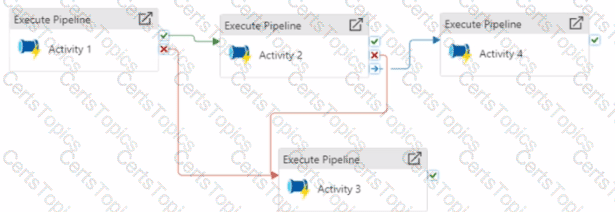
For each of the following statements, select Yes if the statement is true. Otherwise, select No.
NOTE: Each coned selection is worth one point.

You are deploying a lake database by using an Azure Synapse database template.
You need to add additional tables to the database. The solution must use the same grouping method as the template tables.
‘Which grouping method should you use?
You are designing a partition strategy for a fact table in an Azure Synapse Analytics dedicated SQL pool. The table has the following specifications:
• Contain sales data for 20,000 products.
• Use hash distribution on a column named ProduclID,
• Contain 2.4 billion records for the years 20l9 and 2020.
Which number of partition ranges provides optimal compression and performance of the clustered columnstore index?
Note: This question is part of a series of questions that present the same scenario. Each question in the series contains a unique solution that might meet the stated goals. Some question sets might have more than one correct solution, while others might not have a correct solution.
After you answer a question in this section, you will NOT be able to return to it. As a result, these questions will not appear in the review screen.
You plan to create an Azure Databricks workspace that has a tiered structure. The workspace will contain the following three workloads:
A workload for data engineers who will use Python and SQL.
A workload for jobs that will run notebooks that use Python, Scala, and SOL.
A workload that data scientists will use to perform ad hoc analysis in Scala and R.
The enterprise architecture team at your company identifies the following standards for Databricks environments:
The data engineers must share a cluster.
The job cluster will be managed by using a request process whereby data scientists and data engineers provide packaged notebooks for deployment to the cluster.
All the data scientists must be assigned their own cluster that terminates automatically after 120 minutes of inactivity. Currently, there are three data scientists.
You need to create the Databricks clusters for the workloads.
Solution: You create a High Concurrency cluster for each data scientist, a High Concurrency cluster for the data engineers, and a Standard cluster for the jobs.
Does this meet the goal?
You have an Azure Databricks workspace and an Azure Data Lake Storage Gen2 account named storage!
New files are uploaded daily to storage1.
• Incrementally process new files as they are upkorage1 as a structured streaming source. The solution must meet the following requirements:
• Minimize implementation and maintenance effort.
• Minimize the cost of processing millions of files.
• Support schema inference and schema drift.
Which should you include in the recommendation?
You have an Azure subscription that contains an Azure Synapse Analytics dedicated SQL pool named Pool1.
You use Azure Monitor.
You need to monitor the performance of queries executed in Pool1.
Which log should you query?
You have an Azure Synapse Analytics dedicated SQL pool named SQL1 that contains a hash-distributed fact table named Table1.
You need to recreate Table1 and add a new distribution column. The solution must maximize the availability of data.
Which four actions should you perform in sequence? To answer, move the appropriate actions from the list of actions to the answer area and arrange them in the correct order.

You have an Azure Synapse Analytics workspace that contains three pipelines and three triggers named Trigger 1. Trigger2, and Tiigger3.
Trigger 3 has the following definition.
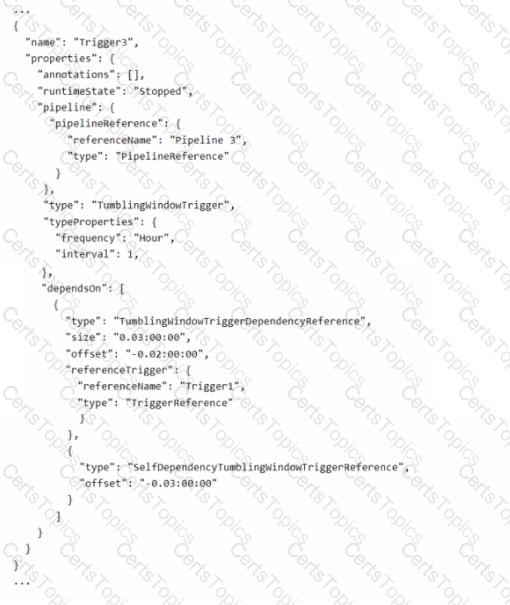

You have an Azure data factory.
You need to examine the pipeline failures from the last 60 days.
What should you use?
You are building an Azure Stream Analytics job that queries reference data from a product catalog file. The file is updated daily.
The reference data input details for the file are shown in the Input exhibit. (Click the Input tab.)
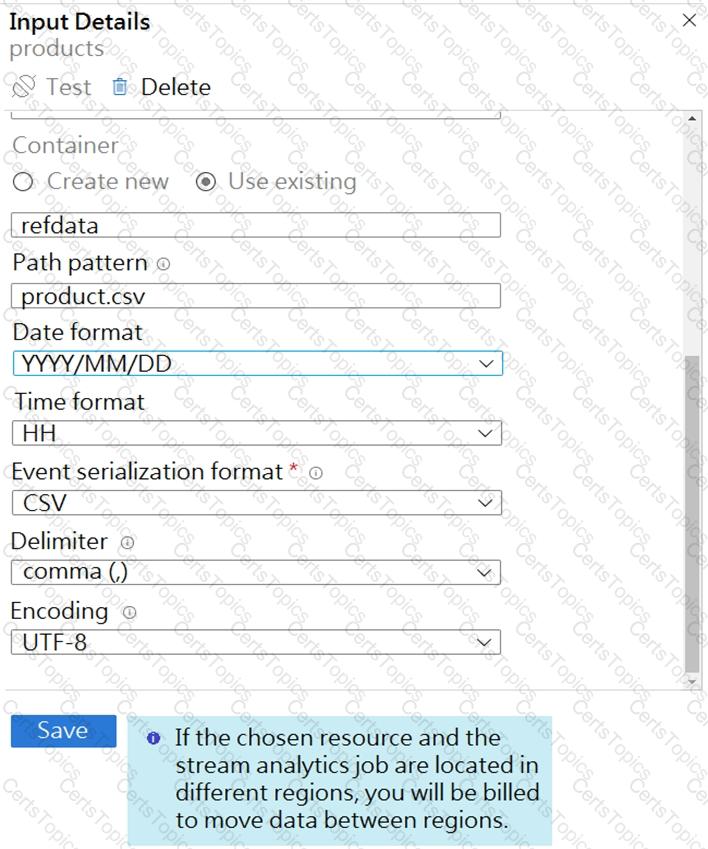
The storage account container view is shown in the Refdata exhibit. (Click the Refdata tab.)

You need to configure the Stream Analytics job to pick up the new reference data.
What should you configure? To answer, select the appropriate options in the answer area.
NOTE: Each correct selection is worth one point.
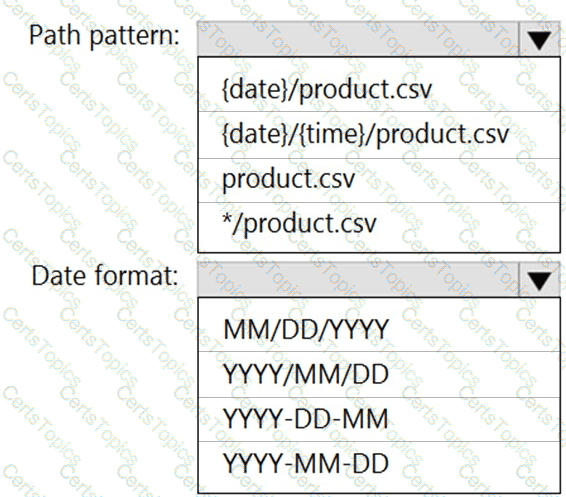
You are designing an enterprise data warehouse in Azure Synapse Analytics that will store website traffic analytics in a star schema.
You plan to have a fact table for website visits. The table will be approximately 5 GB.
You need to recommend which distribution type and index type to use for the table. The solution must provide the fastest query performance.
What should you recommend? To answer, select the appropriate options in the answer area.
NOTE: Each correct selection is worth one point.
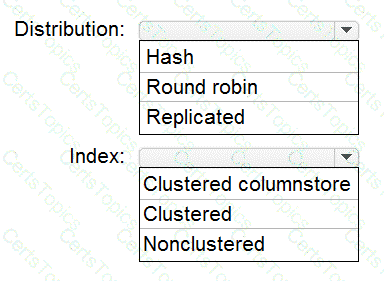
You have an Azure Synapse Analytics dedicated SQL Pool1. Pool1 contains a partitioned fact table named dbo.Sales and a staging table named stg.Sales that has the matching table and partition definitions.
You need to overwrite the content of the first partition in dbo.Sales with the content of the same partition in stg.Sales. The solution must minimize load times.
What should you do?
You manage an enterprise data warehouse in Azure Synapse Analytics.
Users report slow performance when they run commonly used queries. Users do not report performance changes for infrequently used queries.
You need to monitor resource utilization to determine the source of the performance issues.
Which metric should you monitor?
You have an Azure Synapse Analytics dedicated SQL pool.
You plan to create a fact table named Table1 that will contain a clustered columnstore index.
You need to optimize data compression and query performance for Table1.
What is the minimum number of rows that Table1 should contain before you create partitions?
You have an Azure Synapse Analytics dedicated SQL pool that contains a large fact table. The table contains 50 columns and 5 billion rows and is a heap.
Most queries against the table aggregate values from approximately 100 million rows and return only two columns.
You discover that the queries against the fact table are very slow.
Which type of index should you add to provide the fastest query times?
You are building a data flow in Azure Data Factory that upserts data into a table in an Azure Synapse Analytics dedicated SQL pool.
You need to add a transformation to the data flow. The transformation must specify logic indicating when a row from the input data must be upserted into the sink.
Which type of transformation should you add to the data flow?
You need to implement an Azure Databricks cluster that automatically connects to Azure Data Lake Storage Gen2 by using Azure Active Directory (Azure AD) integration.
How should you configure the new cluster? To answer, select the appropriate options in the answer area.
NOTE: Each correct selection is worth one point.
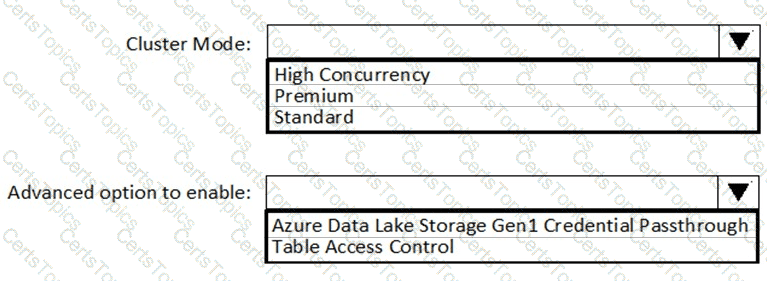
You have an Azure Data Factory pipeline that has the activities shown in the following exhibit.
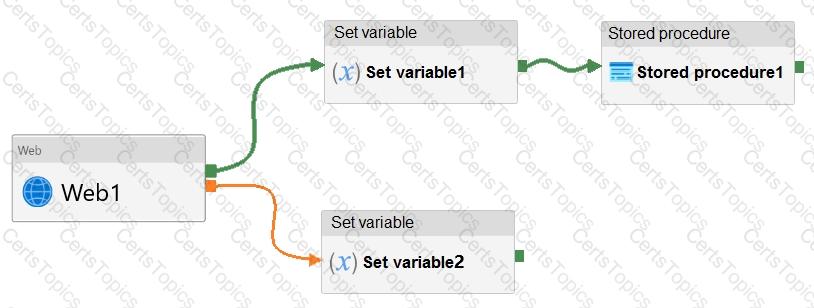
Use the drop-down menus to select the answer choice that completes each statement based on the information presented in the graphic.
NOTE: Each correct selection is worth one point.

You need to implement versioned changes to the integration pipelines. The solution must meet the data integration requirements.
In which order should you perform the actions? To answer, move all actions from the list of actions to the answer area and arrange them in the correct order.
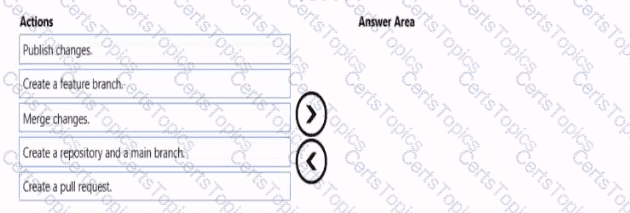
You need to design an analytical storage solution for the transactional data. The solution must meet the sales transaction dataset requirements.
What should you include in the solution? To answer, select the appropriate options in the answer area.
NOTE: Each correct selection is worth one point.
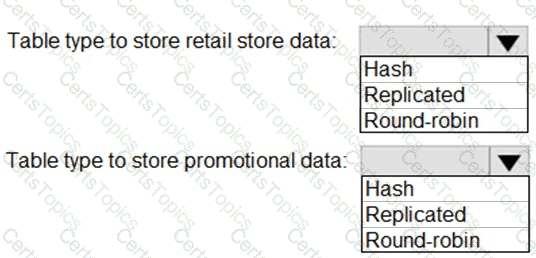
You need to implement the surrogate key for the retail store table. The solution must meet the sales transaction
dataset requirements.
What should you create?
You need to design a data storage structure for the product sales transactions. The solution must meet the sales transaction dataset requirements.
What should you include in the solution? To answer, select the appropriate options in the answer area.
NOTE: Each correct selection is worth one point.

You need to design the partitions for the product sales transactions. The solution must meet the sales transaction dataset requirements.
What should you include in the solution? To answer, select the appropriate options in the answer area.
NOTE: Each correct selection is worth one point.
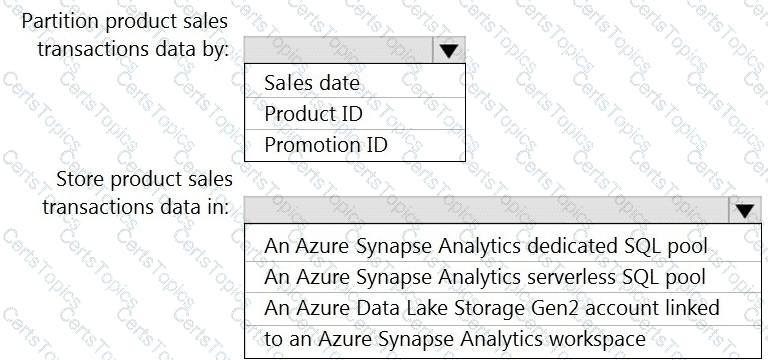
You need to implement an Azure Synapse Analytics database object for storing the sales transactions data. The solution must meet the sales transaction dataset requirements.
What solution must meet the sales transaction dataset requirements.
What should you do? To answer, select the appropriate options in the answer area.
NOTE: Each correct selection is worth one point.

You need to ensure that the Twitter feed data can be analyzed in the dedicated SQL pool. The solution must meet the customer sentiment analytics requirements.
Which three Transaction-SQL DDL commands should you run in sequence? To answer, move the appropriate commands from the list of commands to the answer area and arrange them in the correct order.
NOTE: More than one order of answer choices is correct. You will receive credit for any of the correct orders you select.

You need to integrate the on-premises data sources and Azure Synapse Analytics. The solution must meet the data integration requirements.
Which type of integration runtime should you use?
You need to design a data ingestion and storage solution for the Twitter feeds. The solution must meet the customer sentiment analytics requirements.
What should you include in the solution? To answer, select the appropriate options in the answer area
NOTE: Each correct selection b worth one point.

You need to design a data retention solution for the Twitter feed data records. The solution must meet the customer sentiment analytics requirements.
Which Azure Storage functionality should you include in the solution?
What should you recommend using to secure sensitive customer contact information?
What should you recommend to prevent users outside the Litware on-premises network from accessing the analytical data store?
What should you do to improve high availability of the real-time data processing solution?
Which Azure Data Factory components should you recommend using together to import the daily inventory data from the SQL server to Azure Data Lake Storage? To answer, select the appropriate options in the answer area.
NOTE: Each correct selection is worth one point.
